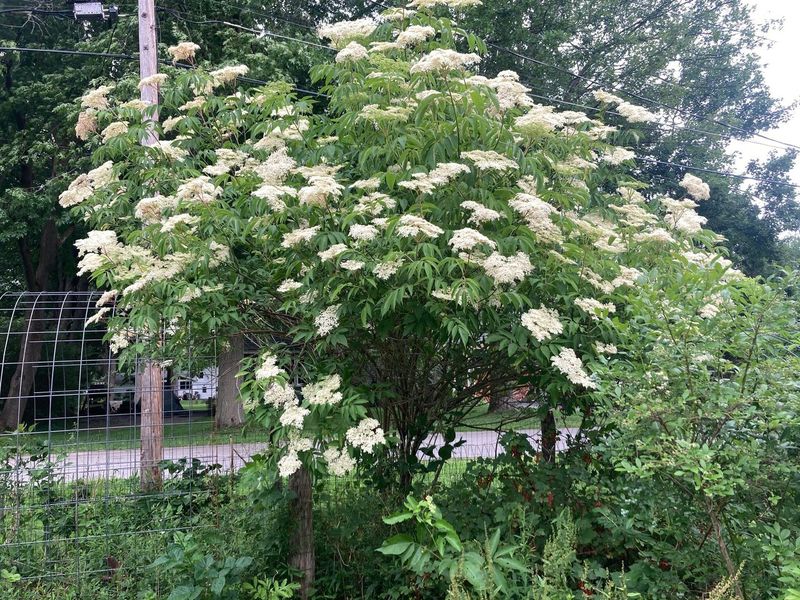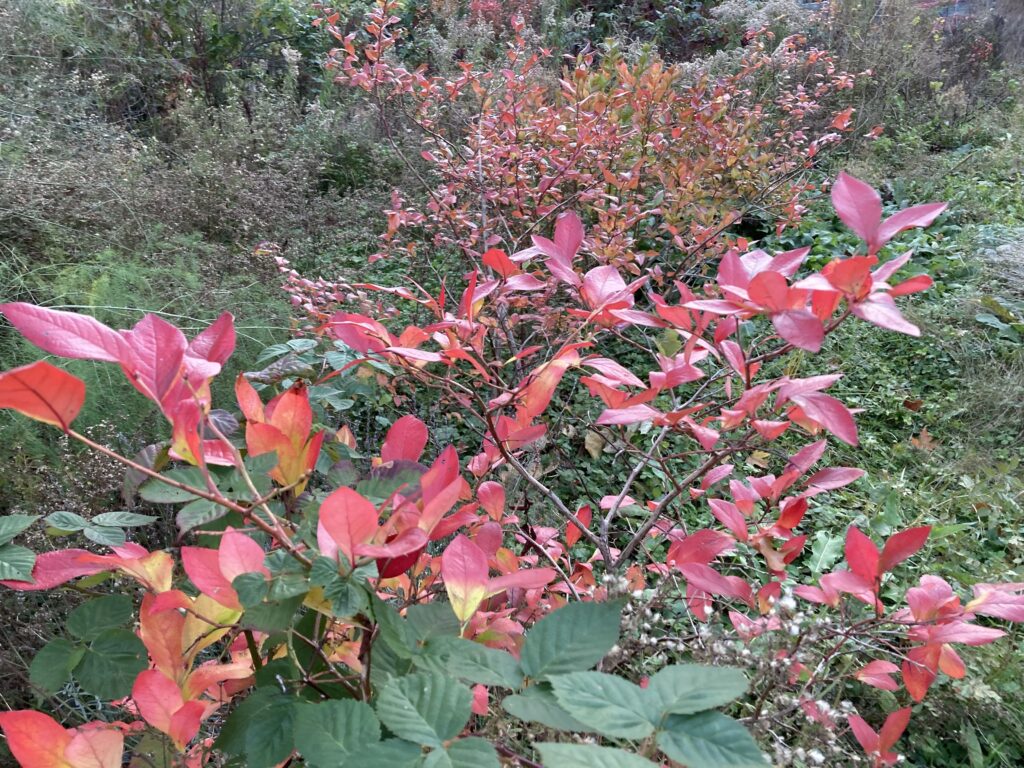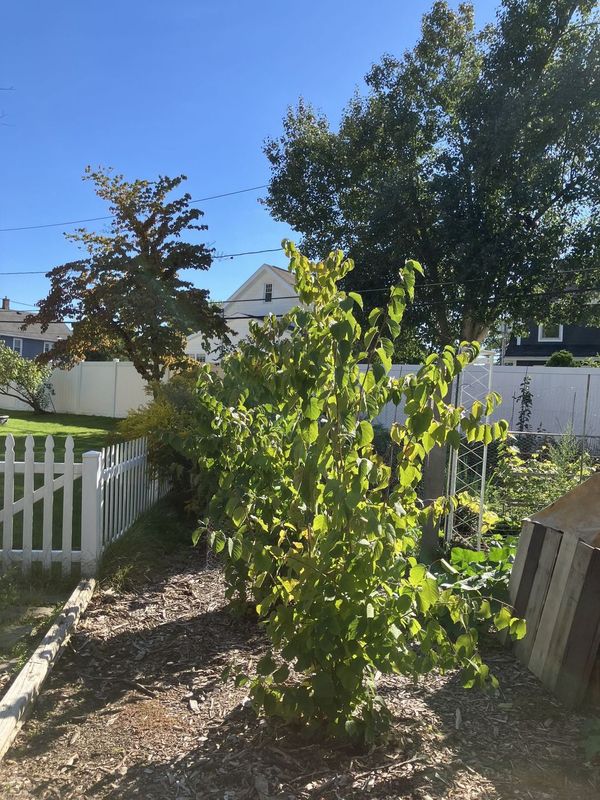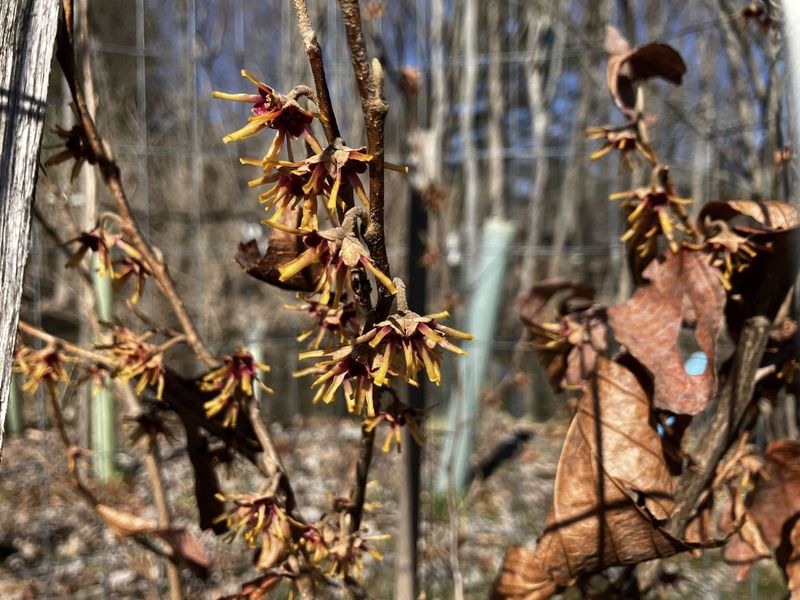
I think native bushes (aka shrubs) are the most underrated of landscaping possibilities. Because of their size, they are relatively easy to handle for planting and pruning and fit into many different spaces such as under trees, under the utility lines, as a living hedge, lining a walkway, and even tucked into a shady corner. Many shrubs are incredibly beautiful several weeks or months of the year. Adding bushes/ shrubs to our yards (even in pots if you’re a renter) is an opportunity to increase biodiversity, add pollinator and wildlife food and habitat, and even grow foods yummy to humans. Shrubs serve as nest sites, cover, and pollen, nectar, and food for birds, insects, caterpillars, and mammals. If you don’t want to share with wildlife, you can net the shrubs.
A shrub is a multi-stemmed woody perennial plant generally smaller than trees and ranging from 1.5 to 26 feet tall. Given that native shrubs feed native critters, how do we choose from the dozens of native options? One approach is to pick a spot that’s available and observe the conditions there—sun or shade, wet or dry, near salted pavement, walnuts overhead. Alternatively, choose a shrub that appeals to you; look up its growing conditions and see if you have a space where it will thrive. Many shrubs will grow outside of their preferred conditions but may struggle, producing fewer flowers and fruit. Think “right plant, right place” while remembering that even good sources provide conflicting information because shrubs are quite versatile.
As I write this, I am enjoying the subtle beauty of my witchhazel (Hamamelis virginiana) planted near the creek where the soil is seasonably wet. Conversely, a cluster thrives high on a hill in Highland Park in Rochester. A host plant for sixty-nine different butterflies and moths (including the Spring Azure Butterfly), part of its delight is the mystery of just exactly when it will flower. Sometimes it’s November. This year, the sweet fragranced, wispy, rust color blossoms appeared in March. As I prune to keep it shrubby-sized, I peel the bark from the clippings to save for medicine. (Only use medicinal plants under proper guidance.)

American hazelnuts or filberts (Corylus americana) make an amazing privacy edge during the part of the year when they are leafed out, which coincides with weather warm enough to enjoy hanging out in our yards. If privacy is your main consideration, plant a double staggered row to enjoy the natural thicket that forms over time and can be managed with pruning. Hazelnuts are a larval host plant for the spectacular Luna moth and others of its stunning Saturniidae relatives. Hazelnuts prefer full or part-sun and moist or dry soils. The fruit (nuts) are unusual and beautiful as is the foliage and spring catkins. Pay close attention to harvest time, as your resident birds, deer, and other mammals might beat you to it.
American red (Sambucus racemosa) and black (S. canadensis) elderberry may be some of the most versatile native shrubs in terms of growing conditions. They grow in wet soil, are drought tolerant, and prefer full sun while tolerating significant shade. Whenever I give a tour of my food forest garden, I share being humbled by nature and the elderberry shrubs, telling how I carefully selected some named varieties (which, for anyone keeping score, are not native cultivars) fourteen years ago and planted them where the books said would be their perfect home. About five years ago, a new elderberry unexpectedly appeared on the opposite corner of my garden where soils are drier, and shade is abundant. That lone bush is easily twice the size of the others and produces four times the flowers and fruit! After the pollinators and I enjoy the lacy beauty of the creamy white umbrella-like flowers, myriad critters and I revel in the bountiful berries.
I remember seeing a video of a person harvesting forty quarts of berries from one bush—the prolific black chokeberry (Aronia melanocarpa). When I read that the black chokeberries have more antioxidants than the aforementioned elderberry and host more than 100 insect species, I knew I needed at least one. They require little care—just a little pruning every year—and are happy to grow in lots of conditions including full or part-sun and dry to moist or even boggy soils. In summer, they have sweet clumps of white flowers that provide nectar for the coral hairstreak butterfly. The books say to leave the black-purple fruit to sweeten on the bushes until after the first frost. But in my yard, the birds don’t wait until then, so I gather them in September for fruit leather and tuck some in the freezer to mix with other fruits for cobbler. (Aronia and blackberry is my favorite combo!) Jam makers take notice: aronia fruit are very high in pectin. And did I mention the brilliant red fall foliage?


Smaller, shady spot? Ribes triste or American red currant is native or naturalized, depending on the source, and thrives in shaded soils that keep their roots cool. Hummingbirds feed from their yellow flowers. One bush will provide an abundance of currants to eat fresh in salads and yogurt, dehydrated or frozen for winter baking. As they are an alternate host for the white pine blister rust fungus, most recommendations are to plant currants at least 200 feet from neighboring Eastern white pines or to plant resistant varieties instead of native cultivars.
Thanks in part to Robin Wall Kimmerer’s book The Serviceberry, folks are rediscovering this delicious fruit with many names that tastes similar to a blueberry with a hint of apple or almond flavor from the seeds. A native shrub form, the lovely shadbush (Amelanchier amabilis), is one of the many juneberries you’ll find both in the wild and in native plant nurseries.
Witchhazel, hazelnut, and elderberry are juglone tolerant so can live under and near walnut trees as can some species I don’t have space to include—spicebush (Lindera benzoin), Northern wild raisin (Viburnum cassinoides), Eastern pasture rose (Rosa carolina), and pasture rose (R. palustris), May I also recommend ninebark (Physocarpus opulifolius), buttonbush (Cephalanthus occidentalis), and, of course, the luscious native blueberries (Vaccinium spp)?
REMEMBER
- Keep children in mind if planting a shrub with beautiful berries that are poisonous to humans.
- Be certain of a plant’s identity and safe uses before consuming any parts of it.
Patty Love, founder of barefootpermaculture.com, is a Certified Permaculture Designer and Teacher who wanders barefoot in her creekside yard, sipping foraged tea, marveling at nature, and cheerfully greeting her neighbors, some of whom have dubbed her food forest garden “the nature preserve.”
RESOURCES
Learn more about native plants and the species they support
– pfaf.org
This article originally appeared in the May/June 2025 issue of Upstate Gardeners’ Journal.
Views: 25




